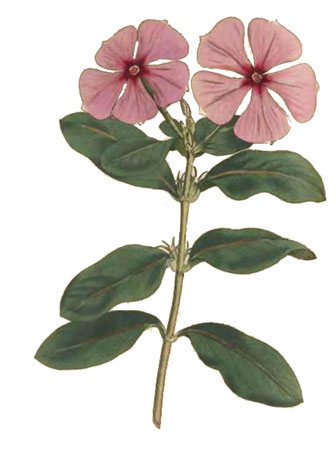Periwinkle Pink – Catharanthus roseus – Vinca rosea
An evergreen shrub height of 30 60 cm, families kutrovыh (Apocynacеae). Distributed in all tropical and subtropical countries. For medical purposes harvested aerial parts plants.

Periwinkle Pink – Chemical composition
In the grass contains a vinca 60 alkaloidov, belonging to the group of indole alkaloids. The most interesting of them are vinblastine, vynkrystyn, leyrozin, lejrozidin, rozidin, vyrozyn, peryvyn.
Periwinkle Pink – Pharmacological properties
Galenic plant in an experiment on laboratory animals depress leucopoiesis, have antibacterial activity, prolonged hypotensive properties minutes pronounced hypoglycemic activity.
The biological activity of the plant depends on the content of alkaloids and, in particular, on the pharmacological activity of vinblastine and leyrozina. In the experiment, the best studied anti-tumor properties of the plant alkaloids. Vinblastine is characterized by a broad spectrum of antitumor effect, than leyrozin. For Example, vinblastine active against 8 strains of transplantable animal tumors, and leyrozin - only in respect of 5 strains. When studying the effect of vinblastine and leyrozina on the life of the simplest Eugleua Grasilis, Ochromones malanensis and Tetrahymena pyriformis It was found, leyrozin that inhibits the viability of all three species of microorganisms, and vinblastine has a depressing effect on the life Tetrahymena pyriformis. Antimicrobial activity of these alkaloids found in plants and against other species of microorganisms. Main - cytotoxic effect vinca alkaloids have been proven to cultures of mouse fibroblast Earle high and low degree of malignancy.
Periwinkle Pink – Use in medicine
Clinical observations indicate a high effectiveness of vinblastine in generalized forms of Hodgkin's disease. So, in patients with Hodgkin's disease stage III-IV remission occurs in 80 % cases during therapeutic treatment for vinblastine 4 Months. Some patients in remission was accompanied by a moderate leukopenia. According to the literature the use of vinblastine in the treatment of patients with Hodgkin's disease gave remission duration 9 Sun in 55-60 % cases. When maintenance treatment vinblastine duration of remission increases to an average of 50 Sun, and does not occur in patients cross-resistance to other cytostatics. Side effects of this therapy are expressed moderately, inhibition of hematopoiesis observed rarely.
Vynblastyn It is also an effective drug for the maintenance of remission, caused by chemotherapeutic agents. He was well tolerated during long-term (2-3 years) maintenance therapy.
A less pronounced effect was observed with temporary remissions in some patients with solid tumors, sarkomoj, lymphosarcoma and sarcoma retikulokletochnoy the appointment of vinblastine. Along with the therapeutic effect (vinblastine, patients received relatively high doses for 8 Months) observed toxic effects - leukopenia, Local irritation, pain, tromboflebit, nausea, fever, baldness.
Vinblastine has some advantages over other cytostatics: It has a faster action (This is especially noticeable at high leukocytosis in patients with leukemia), It does not have a pronounced inhibitory effect on erythropoiesis and thrombocytopoiesis, allowing you to use it sometimes, even with mild anemia and thrombocytopenia. Characteristically, vinblastine that caused inhibition leykopoeza often reversible and dose reduction when appropriate can be restored within a week.
Periwinkle Pink – Formulations, Dosing and Administration
Rozevyn – analogue vynblastyna. Apply with generalized forms of Hodgkin's disease, lymph- and retikulosarkome, chronic mieloza, particularly when resistance to other chemotherapeutic drugs and radiotherapy.
Enter intravenously 1 once a week. The drug was dissolved immediately before administration. For the simultaneous introduction of the contents of the vials (5 mg dry product) dissolved in 5 ml of isotonic sodium chloride solution (enter slowly!); to drip contents of the vial is dissolved in 250 500 ml of isotonic sodium chloride solution.
Treatment starts with administration of the drug at a dose of 0,025- 0,1 mg / kg. Every day after the first administration rozevin control the number of leukocytes in the blood. If the number of leukocytes in the blood is reduced to not more than 3,0*109/l, then after 1 Weeks rozevin injection can be repeated at a dose 0,1 mg / kg. If the number of leukocytes in the blood will decrease to not more than 4,0*109/l, then the next injection of the drug can enter the rate 0,15 mg / kg.
In the absence of a therapeutic (oncolytic) effect, and in the absence of leukopenia rozevin dose can be increased to 0,2 mg / kg intravenous. With the positive therapeutic effects of the drug usually used at a dose of 0,15 mg / kg, which introduced 1 every 1-2 weeks.
The dose should be strictly individualized rozevin and carefully monitor the blood picture, as the number of leukocytes in the treatment of drug should not decrease to less than 3,0*109/l. In more severe leukopenia treatment should be discontinued.
When using rozevin possible weakness, loss of appetite, nausea, vomiting, stomach ache, paresthesia, albuminuria, jaundice, stomatitis, hives, depression, alopecia, phlebitis. It should guard against falling solutions under the skin rozevin, since in this case there is a strong tissue irritation.
Available in ampoules rozevin, containing 0,005 g (5 mg) lyophilized sulfate rozevin, with the application of the solvent (5 ml of isotonic sodium chloride solution). The preparation is stored in a cool place.
